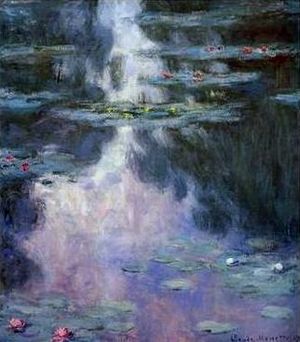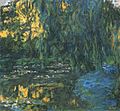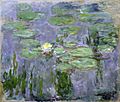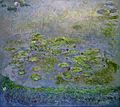Water Lilies facts for kids

Water Lilies (or Nymphéas) is a series of about 250 oil paintings by French Impressionist Claude Monet. The paintings are of Monet's flower garden at Giverny. They were the main focus of Monet's work during the last thirty years of his life. Many of the works were painted while Monet suffered from cataracts. The paintings are on display in museums all over the world, including the Musée Marmottan Monet and the Musée d'Orsay in Paris, the Metropolitan Museum of Art in New York, the Art Institute of Chicago, the Carnegie Museum of Art and the National Museum of Wales, among others.
As part of his extensive gardening plans at Giverny, Monet had a pond dug in his garden and planted with lilies in 1893. He painted the subject in 1899, and thereafter it dominated his art. He worked continuously for more than twenty years on a large-scale decorative series, attempting to capture every observation, impression, and reflection of the flowers and water. The series captures the blooms at different times of the day, and under different atmospheric conditions. After much hesitation, Monet exhibited a group of 48 water-lily paintings in 1909 at the Paris gallery of his art dealer, Paul Durand-Ruel. The series became an enormous financial, popular, and critical hit. By the mid-1910s, Monet had achieved a completely new, fluid, and somewhat audacious style of painting in which the water-lily pond became the point of departure for an almost abstract art.
Related pages
Images for kids
-
Claude Monet, The Water Lilies – The Clouds, 1920–26, Musée de l'Orangerie, Paris
-
Water Lilies, 1919, Metropolitan Museum of Art, New York City
-
Nymphéas, 1915, Musée Marmottan Monet
-
Nymphéas (Waterlilies), 1914–17, National Gallery of Australia
-
Closeup of Water lily pond, one of 18 views of the pond, 1899, Boston Museum of Fine Arts
See also
 In Spanish: Nenúfares (Monet) para niños
In Spanish: Nenúfares (Monet) para niños







